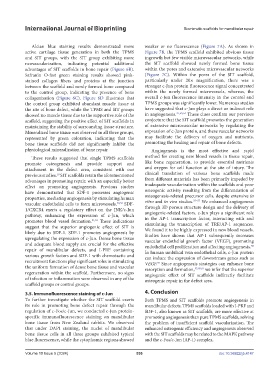Page 544 - IJB-10-5
P. 544
International Journal of Bioprinting Biomimetic scaffolds for mandibular repair
Alcian blue staining results demonstrated more weaker or no fluorescence (Figure 7A). As shown in
active cartilage tissue generation in both the TPMS Figure 7B, the TPMS scaffold exhibited obvious tissue
and SIT groups, with the SIT group exhibiting more ingrowth but few visible microvascular networks, while
neovascularization, indicating potential additional the SIT scaffold showed newly formed bone tissue
advantages of SIT scaffolds in bone repair (Figure 6B). within the pores and extensive microvascular networks
Safranin O-fast green staining results showed pink- (Figure 7C). Within the pores of the SIT scaffold,
stained collagen fibers and proteins at the junction particularly under 20× magnification, there was a
between the scaffold and newly formed bone compared stronger c-Jun protein fluorescence signal concentrated
to the control group, indicating the presence of bone within the newly formed microvessels, whereas, the
collagenization (Figure 6C). Figure 6D illustrates that overall c-Jun fluorescence intensity in the control and
the control group exhibited abundant muscle tissue at TPMS groups was significantly lower. Numerous studies
the site of bone defect, while the TPMS and SIT groups have suggested that c-Jun plays a direct or indirect role
showed no muscle tissue due to the supportive role of the in angiogenesis. 47,53,54 These clues confirm our previous
scaffold, suggesting the positive effect of SIT scaffolds in conjecture that the SIT scaffold promotes the generation
maintaining the stability of surrounding tissue structure. of extensive microvascular networks by regulating the
Mineralized bone tissue was observed in all three groups, expression of c-Jun protein, and these vascular networks
represented by green coloration, indicating that the may facilitate the delivery of oxygen and nutrients,
bone tissue scaffolds did not significantly inhibit the promoting the healing and repair of bone defects.
physiological mineralization of bone repair. Angiogenesis is the most effective and rapid
These results suggested that single TPMS scaffolds method for creating new blood vessels in tissue repair,
promote osteogenesis and provide support and like bone regeneration, to provide essential nutrients
attachment in the defect area, consistent with our and oxygen for cell function at the site of injury. The
previous studies. SIT scaffolds retain the aforementioned clinical translation of various bone scaffolds made
10
advantages in promoting repair, with an especially better from different materials has been primarily impeded by
effect on promoting angiogenesis. Previous studies inadequate vascularization within the scaffolds and poor
have demonstrated that SDF-1 possesses angiogenic osteogenic activity resulting from the differentiation of
properties, mediating angiogenesis by stimulating human osteogenesis-related precursor cells, despite extensive in
55–57
vascular endothelial cells to form microvessels. 49,50 SDF- vitro and in vivo studies. We enhanced angiogenesis
1/CXCR4 exerts a regulatory effect on the JNK/c-Jun through 3D porous structure design and the delivery of
pathway, enhancing the expression of c-Jun, which angiogenic-related factors. c-Jun plays a significant role
promotes blood vessel formation. 51,52 These indications in the AP-1 transcription factor, interacting with and
suggest that the superior angiogenic effect of SIT is stimulating the transcription of TRE/AP-1 sequences.
likely due to SDF-1. SDF-1 promotes angiogenesis by We found it to be highly expressed in new blood vessels.
Studies have shown that AP-1 subsequently increases
upregulating the expression of c-Jun. Dense bone tissue vascular endothelial growth factor (VEGF), promoting
and adequate blood supply are crucial for the effective endothelial cell proliferation and affecting angiogenesis.
58
repair of mandibular defects, and I-PRF containing In human umbilical vein endothelial cells, c-Jun protein
various growth factors and SDF-1 with chemotactic and can induce the expression of downstream genes such as
recruitment functions play significant roles in stimulating VEGF. Since angiogenesis strategies can enhance bone
59
the uniform formation of dense bone tissue and vascular resorption and formation, 55,60,61 we infer that the superior
regeneration within the scaffold. Furthermore, no signs angiogenic effect of SIT scaffolds indirectly facilitate
of infection or inflammation were observed in any of the osteogenic repair in the defect area.
scaffold groups or control groups.
3.5. Immunofluorescence staining of c-Jun 4. Conclusion
To further investigate whether the SIT scaffold exerts Both TPMS and SIT scaffolds promote angiogenesis in
its role in promoting bone defect repair through the mandibular defects. TPMS scaffolds loaded with I-PRF and
regulation of c-Fos/c-Jun, we conducted c-Jun protein- SDF-1, also known as SIT scaffolds, are more effective at
specific immunofluorescence staining on mandibular promoting angiogenesis than pure TPMS scaffolds, solving
bone tissue from New Zealand rabbits. We observed the problem of insufficient scaffold vascularization. The
that under DAPI staining, the nuclei of mandibular enhanced osteogenic efficiency and angiogenesis observed
bone tissue cells in all three groups exhibited typical with the SIT scaffolds may be related to the MAPK pathway
blue fluorescence, while the cytoplasmic regions showed and the c-Fos/c-Jun (AP-1) complex.
Volume 10 Issue 5 (2024) 536 doi: 10.36922/ijb.4147

